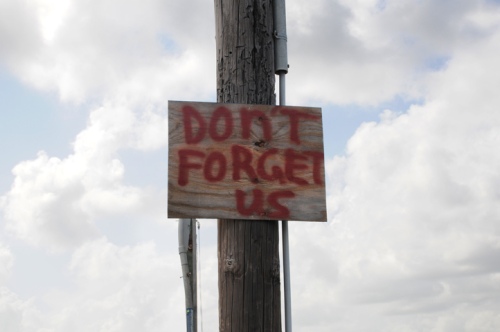
Mom Were OK, Mississippi Gulf Coast, Mid September, 2005 © Copyright of Zoe Strauss
STRAUSS AT HAVERFORD
If you’re in the Philly area and you’ve got any sense, you’ll be making your way to Haverford College tomorrow for the opening of Sea Change, by Zoe Strauss.
Strauss will be there too. Talking and everything.
Friday, January 23rd.
Do it.

Drying Money, Mississippi Gulf Coast, Mid September, 2005 © Copyright of Zoe Strauss

TV on Second Floor, Mississippi Gulf Coast, Mid September, 2005 © Copyright of Zoe Strauss

This is my hometown, Toms River, NJ, 2012. © Zoe Strauss.
PRESS BLURB
In Sea Change, Strauss traces the landscape of post-climate change America. In photographs, vinyl prints, and projected images, Strauss treads the extended aftermath of three ecological disasters: Hurricane Katrina in the Mississippi Gulf Coast (2005); the BP Deepwater Horizon oil spill in Southern Louisiana (2010); and Hurricane Sandy in Toms River, NJ, and Staten Island, NY (2012). Lush and leveled landscapes; graffiti pleas and words of encouragement—Strauss’s camera captures lives decimated and dusting off: the fast and slow tragedies of global warming, the damage we can repair, and the damage we can’t.
THOUGHTS
I had no idea Strauss was working on a survey of disasterscapes in America. Following her 10 years of photographing in Philadelphia and celebrating the colours and characters of her beloved home city — and then presenting her photographs annually beneath Interstate 95 — it makes sense that Strauss would gravitate to the realest of struggles for real people at a time when real (climate) change is unleashing real events.
Sandy, Katrina and the Deepwater Horizon catastrophes left millions of Americans floundering, thousands dead, communities torn from the ground. In the immediate aftermath of such events, attention focuses on the official and governmental responses, but Strauss is more interested in the long tail of disasters and of informal vernacular responses. Strauss seems hell-bent on reminding us that after the camera crews leave, there’s still generations of rebuilding to be done (especially ecologically).
In Sea Change we see Strauss’ usual dark humor and restless documentation of the frayed edges of our nation. She’s holding up a mirror to the inconvenient messiness that we like to think we can deal with quickly and efficiently, but Strauss’ world is in a state of constant entropy, and it’s the invisible, the workers, the poor, the animal kingdom and the dissenters that lose out most when the shit hits the fan.
We all know that we’ve permanently altered our planet’s climate systems; we all know we’re on the hook. But we also know we can look anywhere-else, any time we want. And we know we don’t have to live on the Gulf Coast, or in the path of hurricanes. And we know that when things go south, we can turn our heads to the news and make a distant appraisal about whether the clean-up is happening quick enough or not, or watch some talking heads, or wag our finger at some government official.
Strauss’ victory in all her work — and particularly in Sea Change — is that she marries the visuals in her inquiries and her work so that they sync with her experience of the world. She is keeping herself honest through her photography. Perhaps Strauss can keep us honest too?
Foundational to Strauss’ work too is a deep respect. Zoe is irreverent, for sure, but she is also respectful of people. Entropy is going to happen; change is constant. People are going to win and people are going to lose, amidst change. That’s life. The degree to which people’s fortunes differ … and the degree to which people win and lose … and the degrees to which those statuses are kept permanent, that’s not just “life” though. It’s for us to decide how disaster will effect our collective in the long term. It’s for us to decide on the most equitable distribution of resources when many have literally been swept away.
When people fall down, we help them up. Rebuilding is everyone’s business. In Strauss’ world, love is the response to entropy and its disruptions.
NUMBERS
Running: January 23–March 6, 2015
Reception and opening talk with the artist: Friday, January 23, 4:30–7:30pm
PAPER
The exhibition is accompanied by a publication designed by Random Embassy, Philadelphia, featuring essays by artist Zoe Strauss; The New Yorker contributing writer Mattathias Schwartz; Helen K. White, PhD, Assistant Professor of Chemistry at Haverford College; and a poem by Thomas Devaney, MFA, PEW Fellow and Visiting Assistant Professor of Poetry, Haverford College.

Oiled Water Coming Inland, Waveland, Mississippi, Early July, 2010 © Copyright of Zoe Strauss

Billboard, Mississippi Gulf Coast, Mid September, 2005 © Copyright of Zoe Strauss

We’ll Be Back, Mississippi Gulf Coast, Mid September, 2005 © Copyright of Zoe Strauss
ANY QUESTIONS?
Contact (my mate) Matthew Seamus Callinan, Associate Director, Cantor Fitzgerald Gallery and Campus Exhibitions
mcallina@haverford.edu
Cantor Fitzgerald Gallery, Haverford College, 370 Lancaster Avenue, Haverford, PA 19041
Tel: 610 896 1287

Don’t Forget Us, Mississippi Gulf Coast, July 2010 © Copyright of Zoe Strauss
Filed under: Activist Art, Documentary, Fine Art, Photography: Non-Prison Tagged: Cantor Fitzgerald Gallery, climate change, Deepwater Horizon, global warming, Haverford, Hurricane Katrina, Hurricane Sandy, Katrina, Philadelphia, Sandy, Sea Change, Zoe Strauss




















